Broadcom BK7235 processor combines with OpenHarmony
Huawei MatePad Pro 10.8 gets SuperHub feature with HarmonyOS 3 public beta
Huawei MatePad Paper new update brings unique changes to Notes app
Huawei MatePad Pro 12.6 global users receiving November 2022 update
Huawei Nova 10 and Nova 9 gets November 2022 Update
Huawei Mate X3 sample version begins to rollout, launching soon
Huawei Nova 10 series is now available nationwide in Malaysia
Huawei Mate 50 Pro smartphone back in stock in Malaysia
Old Huawei 5G phones still ruling Chinese smartphone market
Huawei P50 series now avails at heavy 600 yuan discount
Huawei Nova 9 is getting November 2022 firmware
Huawei MatePad Pro 10.8 gets SuperHub feature with HarmonyOS 3 public beta
Huawei MatePad Paper new update brings unique changes to Notes app
It’s time for Huawei P30 Pro November 2022 update, while EMUI 13 is still away
Huawei MatePad Pro 12.6 global users receiving November 2022 update
Download Huawei HMS Core app (6.8.0.332)
Download Huawei Health app (13.0.1.300)
Download Huawei AppGallery App (12.6.1.303)
Download Huawei M Store app (62.5.2.300)
Meet Huawei AppGallery sister – M Store
Huawei MatePad 11 gets new 8GB + 256GB storage version
Huawei MatePad SE tablets sold out in Indonesia
Huawei MateStation X 2022 specs leaked ahead of launch
New Huawei MateStation X 2022 all in one PC is coming
Huawei MateStation X 2022 to feature 12th gen Intel i9 processor
Huawei Watch Buds leaked in short hands-on [Video]
Huawei Watch Buds leak shows earbuds inside a smartwatch
Quick message reply feature rolling out for Huawei Watch D with a new firmware update
Huawei Band 7 NFC Edition now avails at amazingly low price
Huawei Watch 3 Pro new gets taxi-hailing feature
Published
on
By
OpenEuler Community has officially developed and released the OpenEuler 22.09 version with some immersive features for the Euler and HarmonyOS system. Besides, it also brings expansion of computing power and some other high-end functions.
According to the new reports, the OpenEuler 22.09 build adds revamped system images for SW-64 and LoongArch architecture. Further, it supports ARM architecture memory fault tolerance enhancement, SME, and commercial secret acceleration. The latest version also holds Intel SPR kernel and visualization functions.
Apart from the architecture segments, the RISC-V adds four new operating functionalities: QEMU, D1, unmatched, and VisionFive. Additionally, the 22.09 version has also met the adaptation process of Raspberry Pi and Rockchip.
Consequently, one of the essential features of the OpenEuler 22.09 version is the extended support of integration between Euler and the HarmonyOS system. The latest build enables finer interconnection for both tech-pack systems with better optimization.
To ensure the compatibility of software and hardware products, the OpenEuler community has passed the latest build and Euler technology evaluation solution through the 221 certification process. This includes 204 general certificate procedures and 17 OS certificates. This solution works in the following aspects:
Server Scenario:
Based on eBPF tech, Flexible IO strategies of the Euler solution have improved the performance of big data concerns and computing-intensive applications by 10 percent. Besides, it also supports programmable kernels and increased the base performance by 20 percent.
Cloud and Edge Scenarios:
The Euler solution and new build have obtained the cloud-native function with easy runtimes and hybrid deployments. The utilization rate of virtualized resources has hiked by 30 percent. Besides, the memory noise floor is less than 50K, and performance improved by 10 times. It also supports NestOS, OpenStack Yoga version, and more.
Embedded Scenario:
The distributed soft bus has high-security functions, large bandwidth data transmission, and real-time control. Together, these increase the efficiency between Euler and HarmonyOS and explore more innovations.
Developer Tools:
- China Unicom developed Opensd elements for OpenEuler 22.09 supports OpenStack. It can exhibit one-click batch automatic deployment of OpenStack Service Components. As a result, it improves the effectiveness of operation and maintenance.
- GCC plug-in framework helps developers to improve and renovate compliers functions and their sharing ability. This framework supports two types of statistical plug-ins (Inline, and Variable) to provide better security and verification functions.
Desktop Scenario:
It supports UKUI, DDE, Kiran-desktop, GNOME, Xfce, Cinnamon desktop, and other interfaces to provide users with an excellent experience. 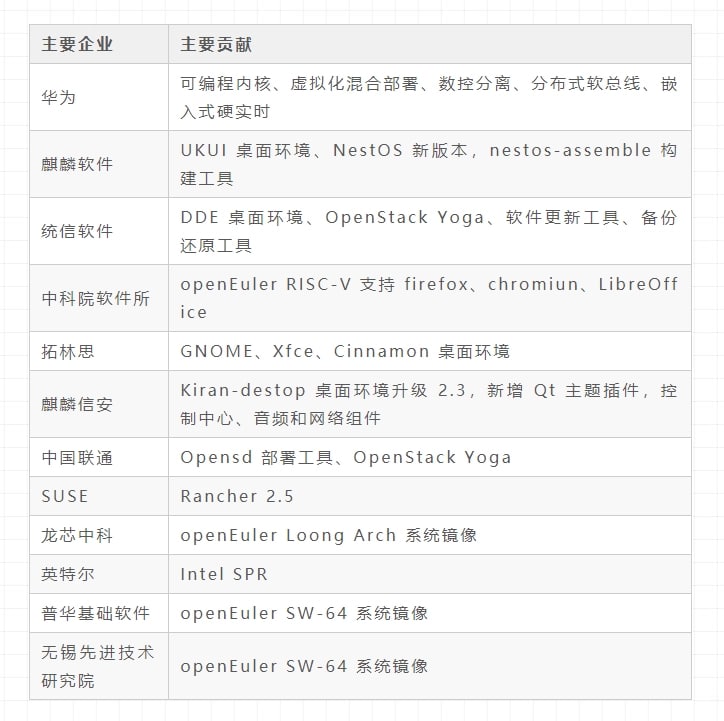
Participation of Developers
This is another innovative execution from the OpenEuler community. The latest version carries 670 million lines of code, 20.10 million lines of new code, and 48,000 lines of original code to the kernel. Alongside, there are more than 12,000 northbound source code packages and a total of 20.12 million lines of new code.
So far, 1265 developers have contributed to the latest build of OpenEuler. It’s worth mentioning that this time, the participation of developers for the new version has increased by 63 percent. This is the largest increase of developers for the OpenEuler till now.
On the other hand, the version also has positive feedback from 400 companies in the community. These companies are Huawei, Kirin Software, Tongxin Software, China Unicom, SUSE, Intel, Ultrasonic Fusion, Wuxi Advanced Technology Research Institute, Puhua Basic Software, and more.
The community is constantly inviting more chips, boards, and machine manufacturers to participate in the hardware driver adaptation and use the newly-arrived functions of the OpenEuler 22.09 build. You can check the hardware compatibility list HERE.
(Source)
OpenEuler 22.09 based NestOS Cloud system is released
Huawei adds new compiler to OpenEuler operating system
Yash is a graduate of computer science and followed his way into journalism, he is interested in various subjects related to technologies and politics. Yash likes to listen classical songs and has a huge library of classical mixes.
Huawei EMUI November 2022 Updates List
Huawei Watch Buds leaked in short hands-on [Video]
US banned new equipments made by Huawei
Published
on
By
Today, at the 2022 Full Connect Conference, Huawei informed that Euler operating system excelled with a huge number of installations. To date, Euler is actively running 2.45 million products and has offered efficient performance.
Huawei has been serving in the 2022 Full Connect Conference. The event was held from November 7 to November 9. Ultimately, the company unveiled several concepts of HarmonyOS, Kunpeng, Ascend AI, and the Euler system.
While describing technical factors, Huawei’s Executive Director and the ICT Infrastructure Business Management Committee Director – Wang Tao revealed that Huawei Euler has exceeded 2.45 million installations till now.
Significantly, Euler has managed the difficult steps of ecological growth. As of now, it will more productive and reliant in terms of providing services and durable functioning. On the other hand, HarmonyOS has also surpassed 320 million installations.
This is a huge achievement and developers are looking forward to some new tweaks and pinches in the Euler system. However, Huawei hasn’t uttered any word on this matter. 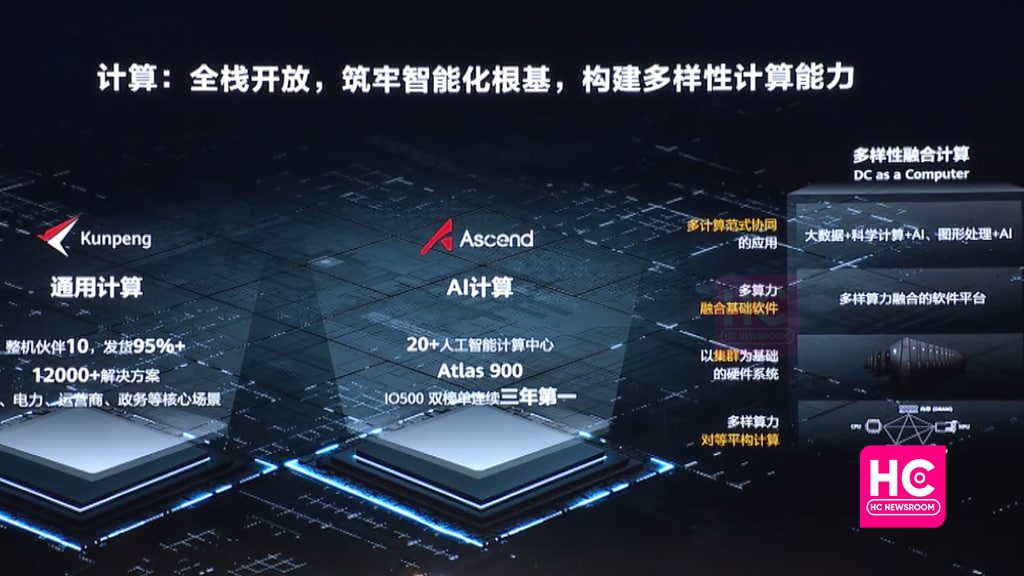
openEuler innovative version
Just like OpenHarmony, Huawei’s openEuler system is an open-source Linux distribution surface. The operating system provides a huge platform for global developers to develop and create innovative software and applications.
In October this year, the new openEuler 22.09 version was released with several thoughtful features. Besides, it also holds finer interconnection capabilities between HarmonyOS and Euler systems. It optimizes the kernel elements and revamps the geographic inspections.
As a result, user experiences better integration and facilities between both systems. Notably, the 22.09 openEuler build includes the participation of 1,265 developers. Further, it has 670 million existing code lines and 20.12 million new code lines.
Read More: New OpenEuler 22.09 version supports better features between Euler and HarmonyOS
Four key factors to digital infrastructure
Additionally, Wang Tao described the four aspects that contribute to digital evolution. These are network architecture, strong computing power, a diversified software ecosystem, and an open digital surface.
Eventually, these measures will bring new opportunities for digitalization.
(Source)
Published
on
By
After the new openEuler 22.09 version, the Euler community has released the NestOS Cloud system. The respective cloud base is the result of the effective efforts of Kylin Software and the experts of the Euler open source community.
Let’s understand what is NestOS, and how it is beneficial for the developers.
NestOS is a cloud operating system, based on the openEuler 22.09 version. In November last year, the EulerOS open source community brought this program into existence. It’s a cloud base system that provides the best container host, and safety features to run related tasks on a large scale.
In the latest development, the community has released the NestOS version of openEuler 22.09 with some enhanced features. This time, the new addition is the nestos-assembler container image, optimized K8S, and an improved OpenStack system.
Together, these components will help in providing a new installation experience to the developers and users. Alongside, the respective cloud system also showcases the dual-root file system, and atomic update to quickly integrate and build up the tasks.
NestOS features:
As stated, this is the new version of NestOS based on the openEuler 22.09 version. Hence, some fresh and unique features are taking place in this system. Let’s read about them one by one. 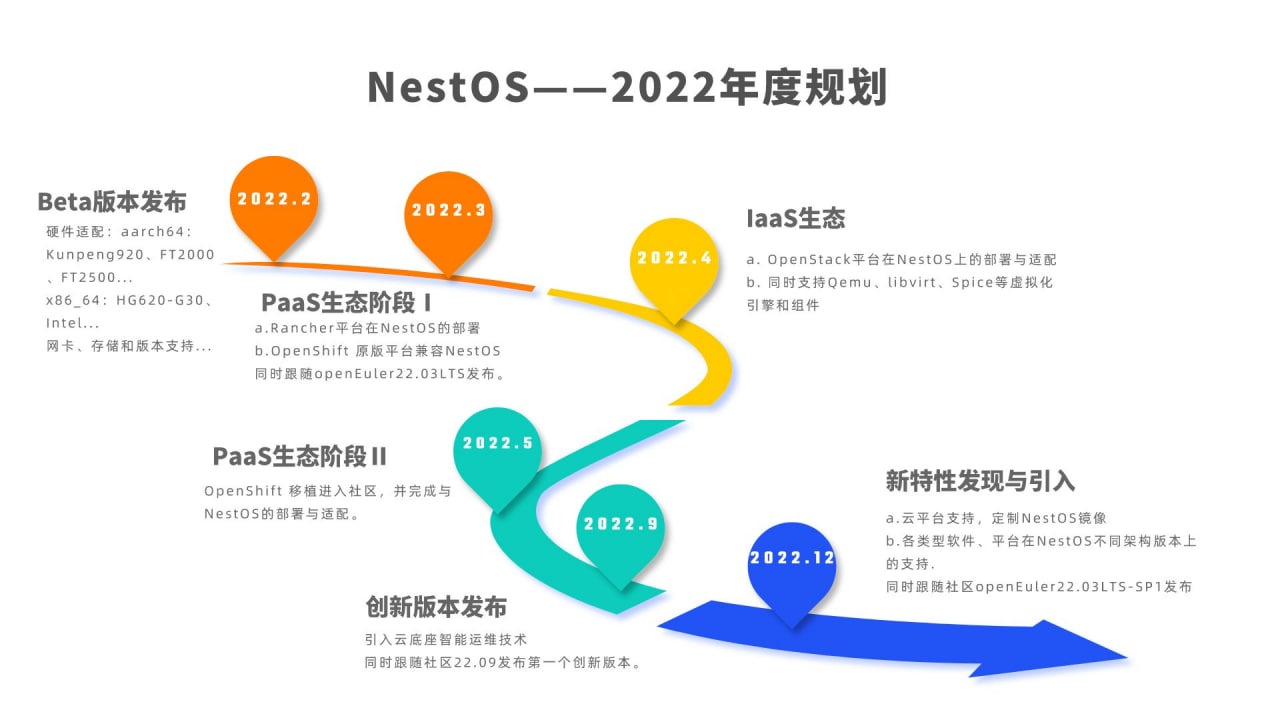
NestOS-assembler
It is a container image tool for building NestOS programs. It uses a few scripts, rpm packages, and tools required in the entire process of NestOS build-up. Currently, the nestOS-assembler released to OEPKG, and the kola component in this assembler supports the NestOS qcow2 and iso images for testing.
NestOS system usually associates with mainstream engines. For instance, iSulad, Docker, and Podman. Further, it can simplify the containerized workloads. The Cloud Base system has the function to begin the work from the same place. Thus, it saves the ignition file to configure the system and access the management.
NestOS Deployment of K8S
So far, Kubernetes introduced a command line system to simplify the installation process and for solving the availability problem. However, using the command line needs several steps and a lot of effort with extreme carefulness.
To eliminate these complicated methods, NestOS deployed the K8S system. It easily supports custom integration of binaries. For instance, kubeadm, kubelet, kubectl, and other packages. Moreover, you can complete the placement of various resources while installing the NestOS with the help of the K8S system.
NestOS OpenStack
You might have heard this term earlier as well. OpenStack is a cloud management project consisting of several essentials. For instance, Nova, Keystone, Glance, Swift, Cinder, etc. It offers firmware to develop and operate public clouds, private clouds, and other virtual mechanisms.
With this feature, it is convenient to manage an immutable framework and update the file configuration. The NestOS 22.09-LTS-SP1 is in the development phase. Interested developers can attend the sig-CloudNative and sig-K8sDistro. 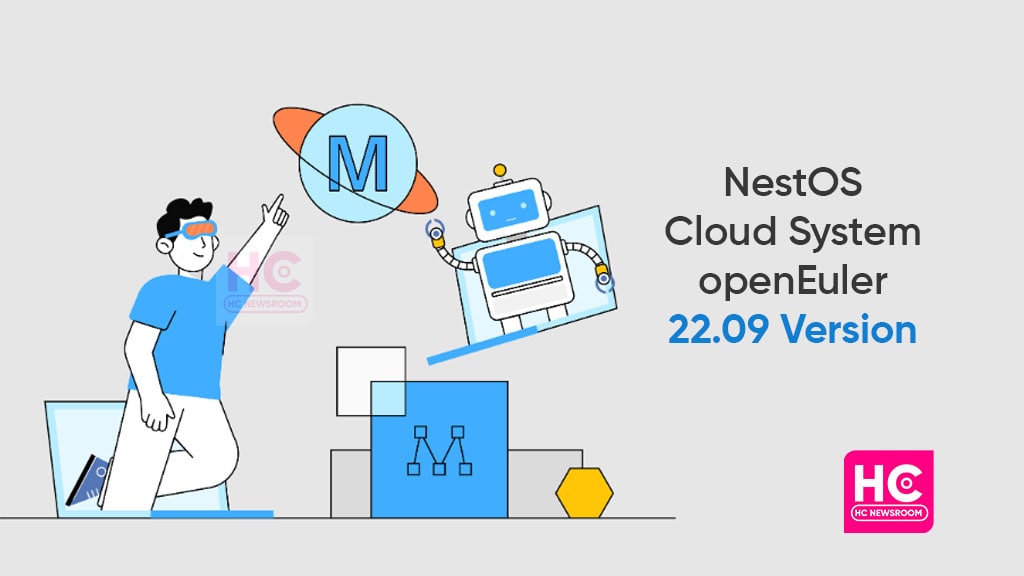
(Source)
Published
on
By
OpenEuler Community has officially announced that the Bisheng compiler is now officially added to the OpenEuler operating system software repository. The latest software addition could be fetched for use cases.
In terms of benchmark, the new Huawei compiler for the OpenEuler operating system has version 2.1.0 and improves 24.3 percent of the hardware and software performance to run smoother and better applications.
Bisheng Compiler:
Bisheng Compiler is a high-performance, reliable, and easily extensible compiler created by Huawei Compiler Lab. It supports C/C++/Fortran and other programming languages.
The compiler also enhances and introduces a variety of compilation and optimization technologies, aiming at certain application scenarios. It is optimized especially in high-performance computing (HPC) scenarios to obtain better performance benefits.
Bisheng 2.1.0 was released on December 30 last year and the current version enhances the loop optimization, structure reorganization optimization, block reorder optimization features, improves the performance of multiple sub-items of SPEC CPU 2017 and HPC workload. 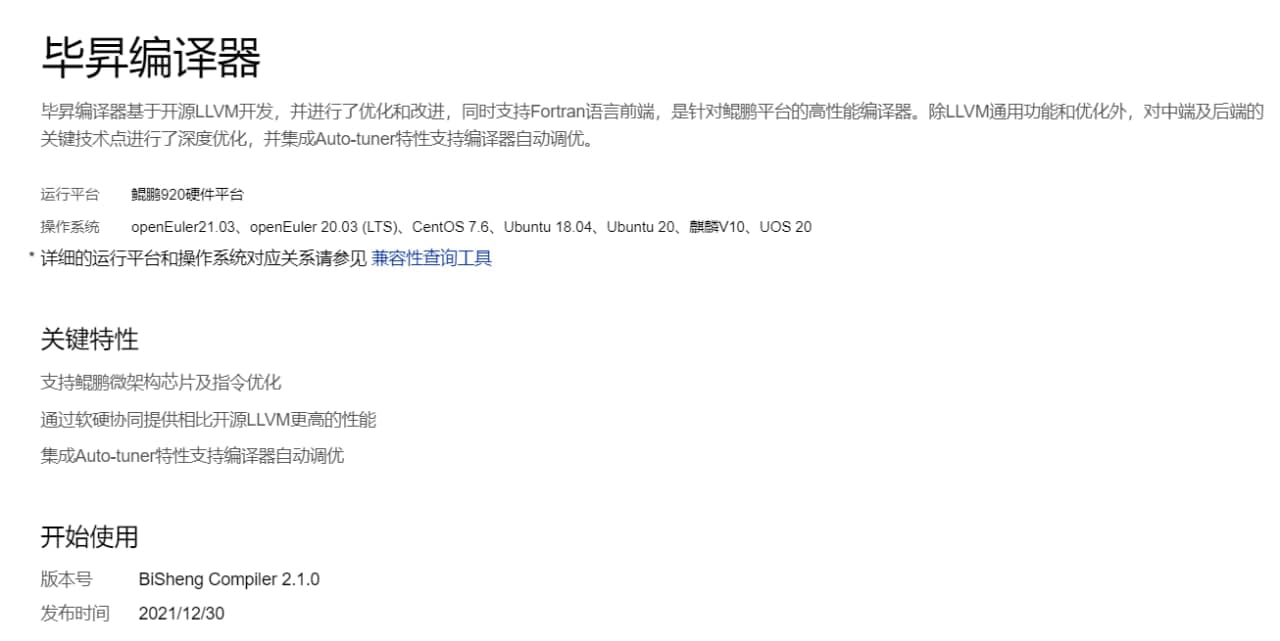
The update adds support for pow initialization immediate data fitting, mathematical function control, and other precision control options, to further enhance the precision tuning options.
This update support multi-threaded parallel programming technology and Input/output enhancements (Fortran 2003) / asynchronous IO features to meet the Kunpeng scene’s needs for the Fortran language ecology.
Features Optimized with this update:
Bisheng Compiler adopts a variety of enhanced compilation optimization techniques, including but not limited to the following optimization features:
Loop optimization:
- Including Loop Unswitching: reduce the number of executions of branch jumps.
- Loop unroll-and-jam: Improve memory and cache locality and utilization.
- Loop Fusion: Directly reuse values in other loops, exposing more instruction scheduling opportunities.
- Loop Distribution: Reduce register pressure in loops and expose more vectorization opportunities.
- Loop Unrolling: This can reduce the number of dynamic instructions and discover more optimization opportunities, such as data reuse, wider instruction scheduling, and improved vectorization Data concurrency.
Memory layout optimization
Convert Array of Structures (AoS) to Structure of Arrays (SoA), and rearrangement optimization of arrays. Through the above method, the hit rate of the Cache will be improved, thereby improving the performance of the program.
Software prefetch
By cooperating with the Kunpeng processor, the Bisheng compiler can accurately model the hardware-related characteristics, so that the compiler prefetch analysis code can accurately simulate the memory access characteristics of the Kunpeng processor, and then insert accurate prefetch instructions into the code, thereby improving the performance of the processor. Cache hit rate to improve program performance.
Automatic vectorization
Combined with the Kunpeng NEON / SVE instruction set, Bisheng Compiler enhances vector automation, converting scalar programs that perform similar operations into vectorized programs so that computer programs can use one instruction to process multiple data and improve program performance.
Autotuner
Based on the ML automatic search technology, through multiple iterations, the optimal option is found in the optimizable space, and then the target program with better performance is compiled.
- Performance – test environment:
- OS: OpenEuler 20.03
- CPU: Kunpeng 920
The Bisheng compiler development team conducted performance evaluation based on the Bisheng compiler version 2.1.0. The SPEC CPU 2017 test report showed that the Bisheng compiler 2.1.0 achieved a comprehensive score of 399 points, and the GCC 9.3.0 comprehensive score was 321 points. Under the same hardware and software environment, the performance of Bisheng compiler is 24.3% higher than that of GCC.
(via – ithome)
Copyright © 2022 Huaweicentral.com